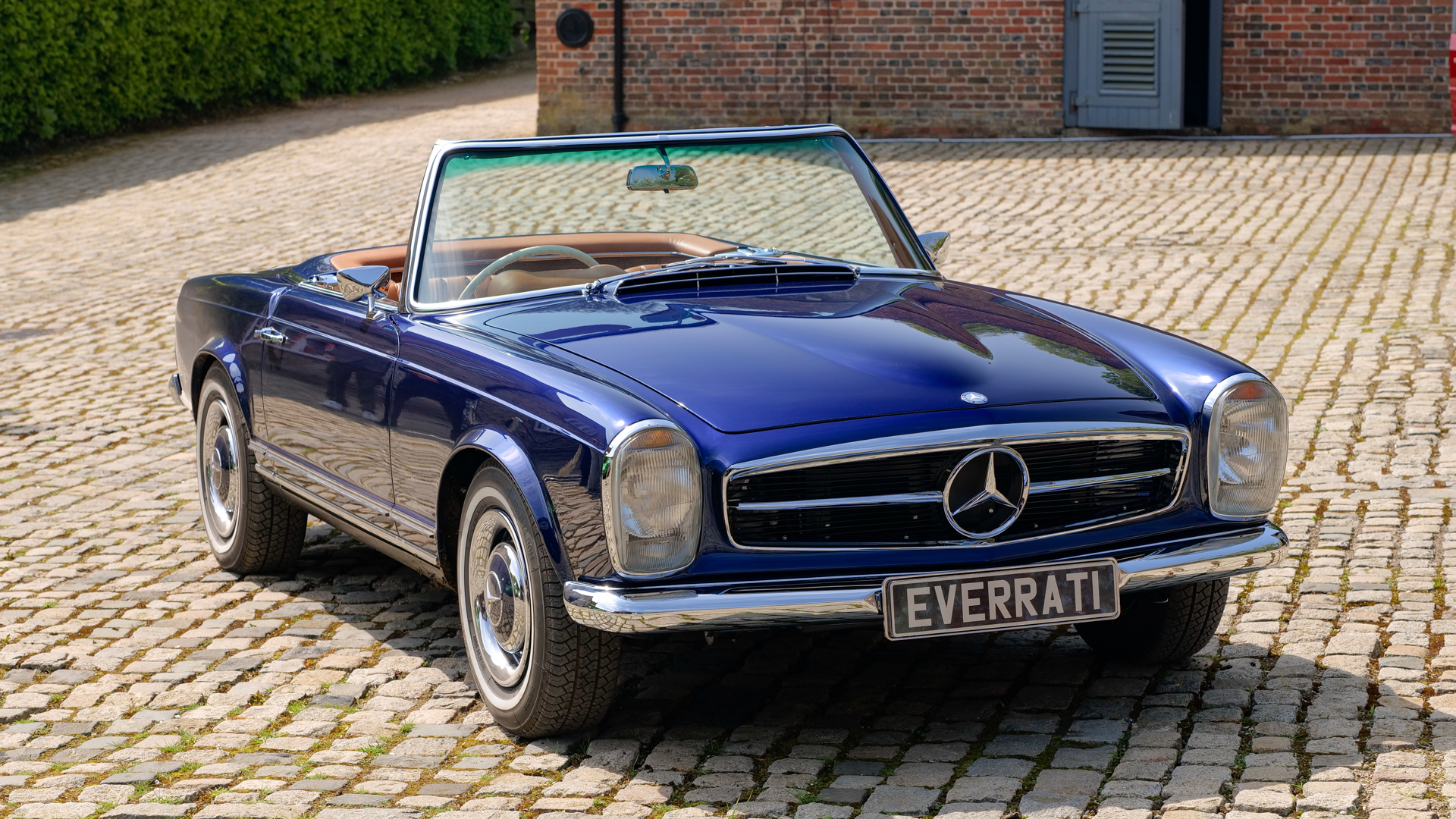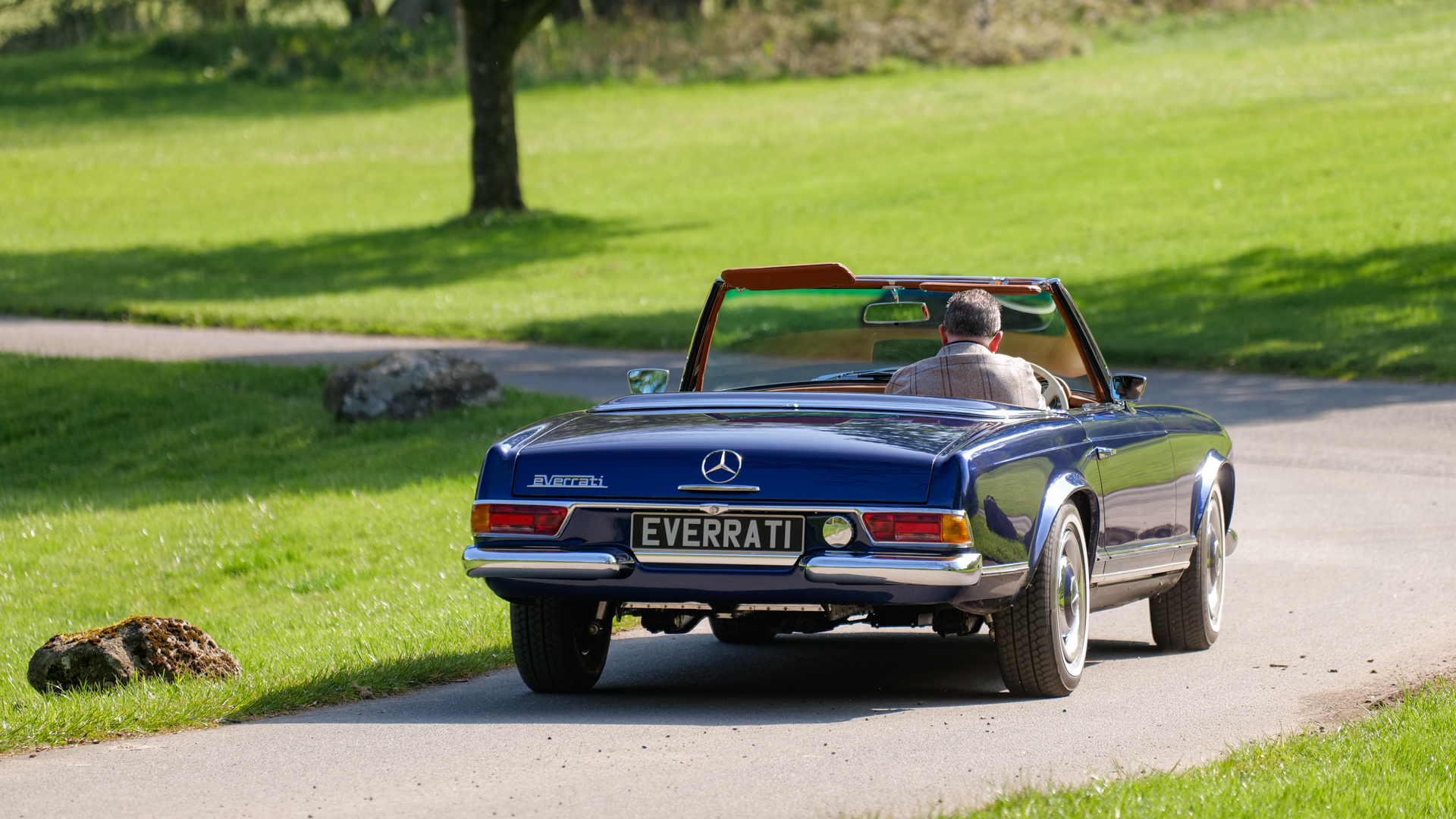Mercedes SL Pagoda by Everrati first drive: 1960s style made electric
Oh Lord, won’t you buy me this electric Mercedes-Benz?


What happens if you want a convertible electric sports car, but don’t quite fancy the MG Cyberster, or a lengthy wait for the Polestar 6? The answer – for now, and if your pockets are sufficiently deep – is the beautiful Mercedes you see before you.
It began life in 1968 as an SL W113, a model better known as the Pagoda. The Pagoda is a two-seat convertible that was produced between 1963 and 1971, and whose owners included the likes of John Lennon, Tina Turner and Audrey Hepburn, plus Harry Styles and F1 driver David Coulthard in more recent years.
The car used to be powered by a 2.5-litre, six-cylinder engine, but this has been removed during a fastidious restoration process, and replaced by a 54 kWh battery and an electric motor producing 300 horsepower. The result is a car dripping in 60s cool, but which operates near-silently, requires almost zero mechanical expertise, and produces no local emissions.

It has been electrified by a British company called Everrati. Founded in 2019 by Justin Luny, who previously forged a successful career in fintech, Everrati also produces electrified examples of the Porsche 964, in convertible or coupe form, the Land Rover Series IIA, classic Range Rover and the Ford GT40, plus bespoke projects. Some may call it sacrilege, but to others it’s the future – and, for anyone concerned about classic engines being thrown away, Everrati’s process is entirely reversible.
There are two versions of electric Pagoda to choose from. The first has the aforementioned battery and motor combo, which produces a range of about 160 miles and a 0-60 mph time of under 8.0 seconds. A longer-legged variant increases battery capacity from 54 kWh to 68 kWh and ups the range to an estimated 200 miles, while lowering the 60 mph sprint time to under 7.0 seconds.
Today I’m driving the less potent model, which is still slightly quicker than the original to sixty and has almost twice the power, plus 300 Nm of torque compared to the original’s 240.

It’s a seriously beautiful thing. The design has been left almost entirely original, aside from seeming to sit slightly lower and therefore looking more compact. Naturally, there's no exhaust protruding from the rear.
Get all the latest news, reviews, deals and buying guides on gorgeous tech, home and active products from the T3 experts
Restored by Mercedes specialists, the Pagoda’s interior also gives very little away about the motor and batteries lurking beneath. There’s the same, large but thin-rimmed steering wheel, the same gear shifter, the same dashboard dials, albeit with subtle Everrati branding, the same heater controls and even a retro radio (but with Bluetooth connectivity).
Classic car owners will be familiar with the firm pull needed to slam the door shut – no modern soft-close systems here – and there’s even the same key to slot into the dashboard and turn. Then, things change. The dashboard looks original, but in the centre of the instrument binnacle are four digital displays that show battery level, gear, battery temperature and speed. Shift the gear stick into drive, release the mechanical handbrake (a bit of a stretch, as it’s in the passenger footwell, as per the original Pagoda) and press the accelerator.

There’s a bit of mechanical whine from the motor, to at least let you know you’re controlling a machine and not gliding along inertly in a golf cart. The ride is soft and the steering is a little vague, in a way that’s almost universal across cars of this era.
Some drivers might miss the skill of changing gear, although the Pagoda was offered with an automatic transmission in period, and of course the sound of a six-cylinder engine. If that’s you then, naturally, this isn’t the car for you.
But what Everrati has found is a customer base who love the design of classic cars; they’re hooked on the fantasy of cruising down the Kings Road, Rodeo Drive or the Pacific Coast Highway in a beautiful classic car, but are put off by the realities of ownership. They have little interest in how the car works, or perhaps are even repulsed by the thought of a classic engine idling (and polluting) in busy city traffic. And they especially don’t want to be seen by their peers or admirers in an internally-combusted classic. Mat Rogers, Nest co-founder and Everrati investor (and its first US customer) once told me how Silicon Valley bonuses are no longer spent on flash supercars.
As much as I like to hear the engines of classic cars, I admit Everrati’s Pagoda has serious appeal. For this drive I’m restricted to the quiet lanes of a private estate draped across the English countryside. It’s a beautiful spring day and, while the estate is positively massive, I’m sharing it with a professional cricket match and what sounded like opera practice. English private estates are just what you’d imagine, and I’m glad I’m not disturbing the tranquillity with an engine.

There are strict speed limits in place, but when granted permission to open it up a bit, the Pagoda surges forward on a pleasing wave of electric torque. It’s not Tesla-quick. It’s more Renault Zoe-quick, if I’m being honest, but when the shove is delivered from an electric drivetrain it always feels more potent, more immediate. And besides, this never was a car to grab by the scruff of its neck and drive hard; it’s a car for cruising, and for that task an electric motor is perfectly suited.
AC home charging and DC fast charging are both supported, and instead of using second-hand components from old Teslas, the motor and battery are described as OEM-grade, having been designed, developed and manufactured in-house by Everrati. Overall weight and its distribution are said to be close to the original car, in a bid to retain its driving character, and Everrati says structural integrity is also retained. There’s a small amount of regenerative braking when you lift the accelerator, but the brake pedal is still needed most of the time, unlike in many modern EVs.

Inside, the beautifully soft leather comes from Bridge of Weir, a Scottish company which claims to produce the global automotive industry’s lowest-carbon leather. It has previously supplied leather for Concorde and the Houses of Parliament, and today’s customers include Range Rover and Aston Martin. Everrari chose a Ferrari blue for the car driven here, but paint colour and interior trim are the buyer’s choice, since the car is stripped down and restored before the switch to electrification takes place.
I can see myself spending many happy hours at the wheel of Everrati’s electrified Mercedes Pagoda. It isn’t a car intended to be driven hard, so the joys of working an engine through the gears were never really there in the first place. It’s a car to cruise, smoothly and quietly, through cities or along country lanes.
For that it feels absolutely perfect, but such perfection doesn't come cheap. At £330,000 plus tax and a donor car, it’s very expensive. A beautifully restored Pagoda normally costs in the region of £100,000 to £150,000, while an example restored by Hemmel – which, incidentally, also offers an electric version – can be had for around £280,000, all in.

Make no mistake about it, the Everrati car is a serious chunk of cash. But its customers clearly aren’t buying a Pagoda as their only car. They aren't deciding between this and something else. They probably have a Porsche Taycan for the daily commute and they’ve probably ordered an electric Range Rover or Mercedes G-Class EV for family duties. They are wealthy individuals who are looking for a classically-stylish, zero-emission alternative to a contemporary supercar. That’s how you should look at Everrati’s Pagoda. Not as a very expensive Mercedes without an engine, but as a guilt-free way of indulging in a passion for beautiful cars.
Alistair is a freelance automotive and technology journalist. He has bylines on esteemed sites such as the BBC, Forbes, TechRadar, and of best of all, T3, where he covers topics ranging from classic cars and men's lifestyle, to smart home technology, phones, electric cars, autonomy, Swiss watches, and much more besides. He is an experienced journalist, writing news, features, interviews and product reviews. If that didn't make him busy enough, he is also the co-host of the AutoChat podcast.
